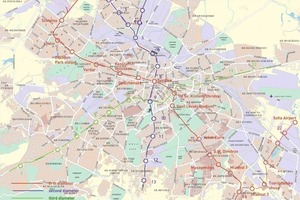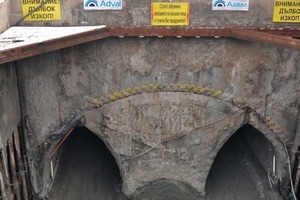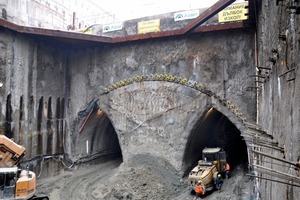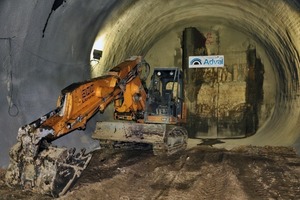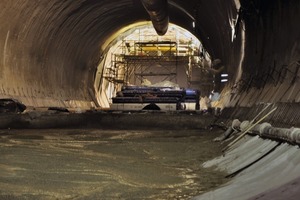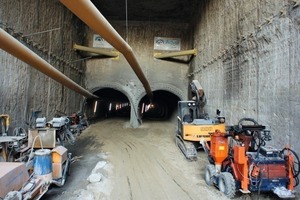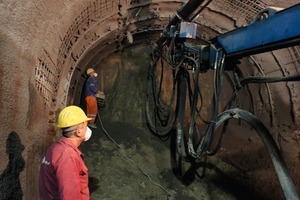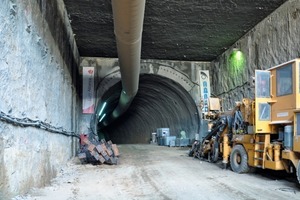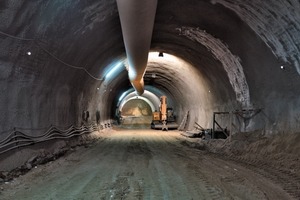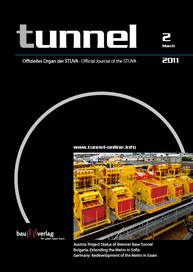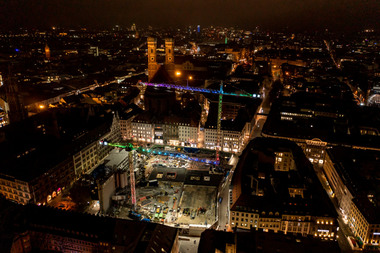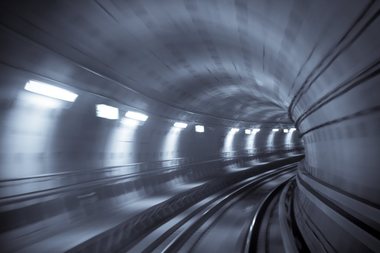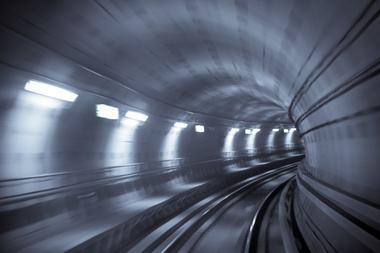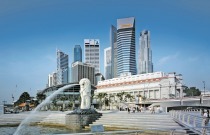Extending the Underground in the Bulgarian Metropolis of Sofia
Since Bulgaria joined the European Union construction activities have grown enormously. The following report presents a number of projects in brief while concentrating on the Sofia Metro project.
The entry of the central and east European states to the European Union (EU) has expanded their opportunities for financing public transport infrastructure. The co-financing of such projects with EU funds also facilitates the building of major and strategically important projects. Such major projects on the one hand improve the quality of life of the people living there by providing a modern and efficient infrastructure quite apart from reducing environmental burdens in urban areas; on the other they offer domestic and international industry new impulses and possibilities for participation and further development.
Bulgaria joined the EU on January 1, 2007. Since then the inhabitants of the capital Sofia have been able to witness that construction activities have grown in leaps and bounds. The neglected infrastructure dating from communist times is in dire need of redevelopment. Fast strategic links between the country’s major centres are lacking quite apart from the fact that inner-urban road networks must be improved to cope with ever growing traffic demands. The capital Sofia with its current nearly 1.5 million inhabitants (unofficial figures put the figure at up to 1.8 million) is simply bursting at the seams and residents are faced with a transport situation that becomes worse every day.
Various Projects
Relief is to be provided first and foremost by underground structures, which are currently being accomplished or were recently completed. For instance the A5 motorway, built by the Turkish company Mapa Chengiz, which connects Sofia with Gjueschevo on the Macedonian border. The route involved 3 twin-bore tunnels with a total length of 1,260 m (tunnel 1: 440 m, tunnel 2: 300 m and tunnel 3: 520 m). All the tunnels were produced by cut-and-cover. The last of the 6 bores was completed in mid-December 2010, at present asphalting is taking place as well as installation work for electrical and safety technology.
A relatively small project is being set up in the vicinity of the town of Lyaskovo in the east of Bulgaria. At the moment a 2-lane road tunnel with a length of 880 m is being driven there. Work commenced at the north portal and is taking place in drill+blast with full excavation.
Driving the “Vyara” inclined heading for a conveyor at the Chelopech Mine may be less important in transport political terms but it still represents a special challenge. A 1,250 m long heading is currently being driven at the copper and gold mine in the west of Bulgaria. The bore is 22 m² large and the longitudinal incline amounts to 17 %, something which additionally hampers the drive. The NATM is being used with the Adval AG tunnelling company in charge of operations. Up till now roughly 1/4th of the overall length has been bored.
Metro Sofia – major Project
However, anyone keen to observe how a major project is set up, is advised to visit the Bulgarian capital where extending the underground system is in full swing (Fig. 1). The client and the operator of the already existing Metro lines is the communal Metropolitan AG. The “Underground network”, which was completed in 1998 after 20 years’ construction, had only a 6.5 km long line with 5 stations at its disposal. In the years that followed it was constantly extended attaining its present form in autumn 2009. Known as “Line 1”, it crosses the city from north west to south east. Within the scope of the new General City Plan it was decided in 2008 to extend the existing line and build 2 new routes.
Line 1 is to be extended at its southern end and once finished will be altogether 29 km long with a total of 23 stations. Line 2 will pass through the city in a north-south direction and will be altogether 17 km long with 17 stations. Line 3 will provide an east-west link and is to be 19 km long with 23 stations. Once completed the Metro network will possess a hub with the 3 lines coming together in the centre of Sofia so that each station on a different line can be reached with a single transfer.
Extending the Metro network is intended to remove existing and future infrastructural bottlenecks, which result from the city’s dynamic growth and the increase in its population. It will signify that Sofia’s transport infrastructure will be adapted to the needs posed by a major city in the 21st century.
Underground Station 8-II
Construction of the Metro Station 8-II began in December 2010. It belongs to the second Sofia Metro Line and is located beneath the Queen Marie-Louise Boulevard, situated between the Largo. Sofia’s central department store (ZUM) and the municipal central market hall. The “Metro Alliance” JV featuring the companies Stroyinject AG, Adval AG and Euro Alliance Engineering AG was commissioned to build the Metro station.
The Metro station is being produced by the NATM. This procedure, which is unusual for Underground stations, is due to archaeological finds, which were discovered above the planned station. Shortly after work started remains of a Roman church, walls of buildings and graves were found during soil investigations, which resulted in the completed planning process being altered as well as delays in finishing the project. Originally the structure was to be set up as a multi-storey construction pit with diaphragm walls, which once operational would house business premises as well as an underground parking facility in addition to the Metro station. The unusual construction method now embarked on – in the form of a tunnel – turned out to be the only way to protect the archaeological finds discovered above the structure. The tunnel – which will be 108 m long with a cross-section of 258 m² - is to be driven in part cross-sections in order to minimise settlements resulting from the drive. The tunnel is to be bored with a counter-drive. In order to attain the desired depth beneath the ruins, 21 m deep construction pits were set up at the northern as well as the southern end of the station. The wall heading drive has started from the northern construction pit, the left wall heading has already been broken through with the breakthrough of the right-hand heading was recently accomplished. At the southern construction put so far the diaphragm walls have been produced; currently anchor and excavation operations are being undertaken (Fig. 3).
The Metro Station 8-II will play a central role in the Sofia Metro network. It is located where 2 Underground lines intersect: Line 1 (Lyulin – Mladost – Tsarigradsko Chaussee) and Line 2 (Nadezhda – Central Station – National Palace OF Culture – Hotel Kempinski).
After being completed the Metro station will help improve the tense traffic situation in the central area of Sofia. Furthermore the archaeological finds will be exhibited at the station so that visitors and local residents can view them.
“Hemus” connecting Tunnel between Metro Stations 10 and 11
The 718.40 m long, single-tube, two-track Metro tunnel runs from the Hemus Hotel via the Cherni Vrah Boulevard up to Zlaten Rog Street and was driven by mining means with a 75 m² profile (Fig. 4). The tunnel is part of Line 2, which passes through the central area of Sofia in a north-south direction.
The driving and supporting operations were concluded on December 7, 2010; at present the concrete floor is being installed and the hydro insulation laid (Fig. 5). The “Metro Trace” JV consisting of the firms Trace Group Hold AG, SB Engineering AG and Trace Sofia AG, received the commission with the SB Engineering AG together with the sub-contractor Adval AG responsible for the tunnelling operations.
The bore was accompanied by extremely complex geological conditions. In spite of tricky groundwater conditions and unstable sandy soils, quality standards and parameters were adhered to and the driving and supporting work completed according to schedule.
Tunnel below the Alexander Malinov Boulevard
The twin-bore tunnel was broken through below the Alexander Malinov Boulevard on February 9, 2011. It links Metro Station 13 (Mladost I) with Metro Station 18. The section forms an extension of the existing Metro Line 1 in the south east of Sofia. The driving and supporting operations were concluded according to schedule (Fig. 6).
Both tunnel bores are 365 m long, the profile amounts to 35 m². The special challenge for the engineers lay on the one hand in the shallow overburden above the bores, which in some cases amounted to only 1.0 m between 2 tunnel bores and 2.0 m between the tunnel bore and the surface and on the other in the extremely unfavourable position of the construction site and the dense traffic frequency in downtown Sofia. The flow of traffic on the surface had to be interfered with as little as possible by construction work, which is why the NATM turned out to be appropriate for the major part of the route in spite of the shallow overburden. The remaining 50 m long tunnel section was executed using cut-and-cover. The “Metro Mladost” JV was commissioned to build the tunnel – consisting of the companies Trace Sofia AG, PSI AG, Adval AG and (responsible for the cut-and-cover section) Stroyinject AG (Fig. 7).
Work on extending this route even further will be embarked on in the near future. This fork will lead to the Business Park Mladost; the tunnel will be twin-track once opened.
Tsarigradsko Chaussee Tunnel
The 375 m long twin-track tunnel between Metro stations 18 and 19 (Tsarigradsko Chaussee) represents a further extension of Metro Line 1. The bored cross-section amounts to 75 m². The major portion of the facility was driven by mining means with the remaining section of roughly 60 m produced via cut-and-cover (Fig. 8).
The driving and supporting operations were concluded on October 28, 2010 and executed by the “Metro Mladost” JV, which comprises the following firms: Trace Sofia AG, PSI AG, Stroyinject AG as well as Adval AG, which was responsible for the NATM (Fig. 9).
At present, work on the inner shell and the hydro insulation is being carried out so that this route section can become operational according to schedule.
Outlook
The most important sections of this project financed by the European Investment Bank and local investors designed to extend the Sofia Underground network is scheduled to be completed in 2013. The client’s priority is clearly directed at those parts of the city facing the greatest problems with traffic as well as opening up their infrastructure underground. Work on Line 3 will probably start in 2015 so that peripheral residential districts in the south west as well as in the east of the city can be connected to the Metro system. After the completion of all 3 Underground lines the capacity will be raised to 50,000 passengers/h (up to 1.2 mill. passengers/d). Then the Metro system will account for roughly 68 % of public commuter transportation in the Bulgarian capital.

